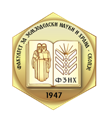ПРИНОС И КВАЛИТЕТ КАЈ ХИБРИДИ ПЧЕНКА ОД FAO300 И FAO700 ГРУПА НА ЗРЕЕЊЕ
YIELD AND QUALITY OF FAO300 AND FAO700 MAIZE HYBRIDS
Клучни зборови:
maize, grain yield, hybrids, FAO300, FAO700Апстракт
The yield and quality of maize, depends of the growing conditions, type of hybrids, as well their adaptation in growing area regarding vegetation period. In this research, have been evaluated the yield and quality of five maize hybrids PKB323, NSSC333, ZPSC704, NS721, NS770, growing in Shtip area.Received results for grain yield, corresponds to other investigations, where hybrids with longer vegetative period (bigger FAO group of maturity), have higher yield. Smallest average grain yield shows the hybrid NSSC 333 (4.05 t/ha), while the largest shows NS 721 (14.05 t/ha). In 2009, average yield of all hybrids was 9.3 t/ha, while in 2010, the total average yield was 9.2 t/ha. Regarding quality properties of the grain, in 2009, PKB 323 shows biggest percentage of total sugars (72.1%), compared with other hybrids. In 2010, it was ZPSC 704 (72.5%). In both years, the biggest protein content was determined in NS 721 (8.9%). The biggest oil content was received in NSSC 333 (3.4%) and PKB 323
(3.6%).
Референци
Bavec, F. and Bavec. M. (2002). Effects of plant population on leaf area index, cob characteristics and grain yield of early maturing maize cultivars. Europian Journal f Agronomy, Volume 16, Issue 2, pg. 151-
Bocanski, J., Petrović, Z., Milić, D. (2001). Međusobna povezanost i nasledjivanje broja redova, mase 1000 zrna i prinosa zrna kukuruza (Zea mays L.). Zbornik radova, vol. 35, 113-121, Naučni institut za ratarstvo i povrtarstvo, Novi Sad, SR Yugoslavija.
Бошев, Д. (2002). Производни и квалитетни особини на некои хибриди пченка во Овче Поле - Докторска дисертација, Скопје.
Vasić, N., Jocković, Dj., Stojaković, M., Simić, L., Jakovlević, L., Bаčanski, J. (2001). Novi NS hibridi kukuruza. Zbornik radova, vol. 35, 97-105, Naučni institut za ratarstvo i povrtarstvo, Novi Sad, SR Yugoslavija.
Golbashy, M., Ebrahimi, M., Khorasani, S.K. and R. Choucan. 2010. Evaluation of drought tolerance of some corn (Zea mays L.) hybrids in Iran. African Journal of Agricultural Research, Vol. 5 (10), pg. 2714-2719.
Djevic, S.M. and R.M. Miodragovic. 1998. Results of exploitation of mobile raining irrigation systems in crop production. 2nd Balkan Symposium on Field Crops, Proceedings 2, pg. 291-295, Institute of Field and Vegetable Crops, Novi Sad, Yugoslavia.
Dragovic, S., Stanojevic, D., Aleksic, V., Dj. Karagic. 1997. The intensity of drought in eastern Serbia and its effect on crop production. Symposium “Drought and plant production”, Proceedings 1, pg. 71-83,
Agricultural research Institute Serbia, Belgrade, Yugoslavia.
Zdunic, Z., Simic, D., Brkic, I., Jambrovic, A., Zdunic, R., Ledencan, T. (2003). Procjena genetskih efekata za visinu biljke na dva specificna para inbred linija kukuruza i sest generacija krizanja. Poljoprivreda 9, 1, 5-8.
Jeftić, S. (1992). Posebno ratarstvo. Nauka, Beograd, SR Yugoslavija. 10. Jovanovic, Z., Prokic, Lj., Stikic, R.(1998). Growth analisys of different maize lines under drought conditions. 2nd Balkan Symposium on Field Crops, Proceedings 2, pg. 131-135, Institute of Field and Vegetable Crops, Novi Sad, Yugoslavia.
Николовски, М. (1989). Производни можности на доцностасните хибриди пченка во одделни подрачја на Македонија при услови на наводнување. Скопје.
Tomov, N., Slavov, N., Aleksandrov, V. (1997). Drought and maize productivity in Bulgaria. Drought and plant production, Proceedings 1, pg. 169-176, Agricultural Research institute Serbia, Belgrade,
Yugoslavia.
Hallauer, A.R., Miranda Filho, J.B. (1988). Quantitative genetics in Maize Breeding. Handbook of plant breeding, Vol. 6, Iowa State University Press.



